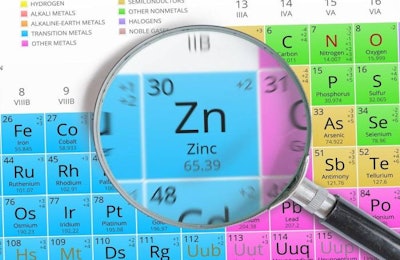
The European Union has lowered the maximum levels of zinc that may be added to feeds for farmed animals.
The new regulation – 2016/1095 – sets the upper limit for complete feed at 180 mg zinc per kg of complete feed for salmonids and calf milk replacers; 150mg/kg for piglets, sows, rabbits and other fish; and 120mg/kg for other species and classes of animal.
Coming into force on July 27, 2016, this regulation replaces an earlier one from 2003, which allows up to 200 mg zinc per kg of complete feed for fish and calf milk replacers, and 150 mg/kg in other feeds.
Concern over environmental impact of excessive zinc
Lowering the levels of zinc in animal feeds was recommended by the European Food Safety Authority (EFSA) in May 2014, to ensure consumer safety, animal health and welfare, and no adverse effects on animal productivity.
EFSA carried out its review because of concerns raised about the possible role of excessive levels of zinc from food-producing animals causing environmental damage in drainage systems and surface water that could be hard to remediate. Furthermore, EFSA stated, the now-widespread inclusion of the feed enzyme phytase in feeds for pigs increases the availability of zinc in some feedstuffs.
With this background, EFSA reviewed the zinc requirements of food-producing and companion animals, the zinc concentration of feed materials, and then the calculated background zinc concentration of complete feed.
This analysis supported the possibility of a considerable reduction in authorized maximum concentration for total zinc in feed, it concluded. EFSA proposed total maximum contents at 150 mg zinc per kg in complete feed for piglets, sows, rabbits, salmonids, cats and dogs; 120 mg/kg in complete feed for turkeys for fattening; and 100mg/kg in complete feed for all other species and categories. These changes would result in an overall reduction of zinc emissions from animal production of about 20 percent, EFSA calculated.
Time-scale
Under the new regulation, authorized zinc compounds and premixes containing them, which are produced and labeled before January 20, 2017, in accordance with the rules applicable before July 27, 2016, may be sold and used until existing stocks are exhausted.
Those same products that are manufactured and labeled before July 27, 2017, in accordance with the rules applicable before July 27, 2016, may still be placed on the market and used until existing stocks are exhausted if they are intended for food-producing animals. For non-food producing animals, production of these products can continue for another year, until July 27, 2018.
As well as changes to the maximum levels for zinc in feeds, the new regulation also covers the authorization of zinc additives to animal feeds.

















